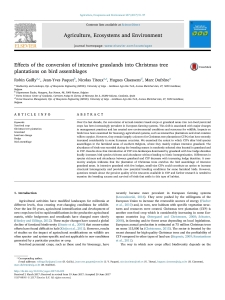Gailly R., Paquet J.Y., Titeux N., Claessens H., Dufrêne M.
Over the last decade, the conversion of annual-rotation based crops or grassland areas into non-food perennial
crops has been increasingly prevalent in European farming systems. This shift is associated with major changes
in management practices and has created new environmental conditions and resources for wildlife. Impacts on
birds have been examined for bioenergy agricultural systems, such as miscanthus plantations and short-rotation
willow coppice. However, they remain largely unknown for Christmas tree plantations (CTPs) that have recently
increased considerably in some European countries. We examined the extent to which CTPs alter bird species
assemblages in the farmland areas of southern Belgium, where they mainly replace intensive grassland. The
abundance of birds was recorded during the breeding season in randomly selected sites located in grassland and
in CTP. Results show that introduction of CTP into landscapes dominated by grassland with low hedge densities
locally increases bird species richness and abundance without leading to biotic homogenization. Differences in
species richness and abundance between grassland and CTP decrease with increasing hedge densities. A community
analysis indicates that the plantation of Christmas trees enriches the bird assemblage of intensive
grassland areas. In intensive grassland with few hedges, small-size CTPs could constitute an option to increase
structural heterogeneity and provide new potential breeding conditions for some farmland birds. However,
questions remain about the genuine quality of the resources available in CTP and further research is needed to
examine the breeding success and survival of birds that settle in this type of habitat.
Consultez la notice complète de l’article sur ORBi

